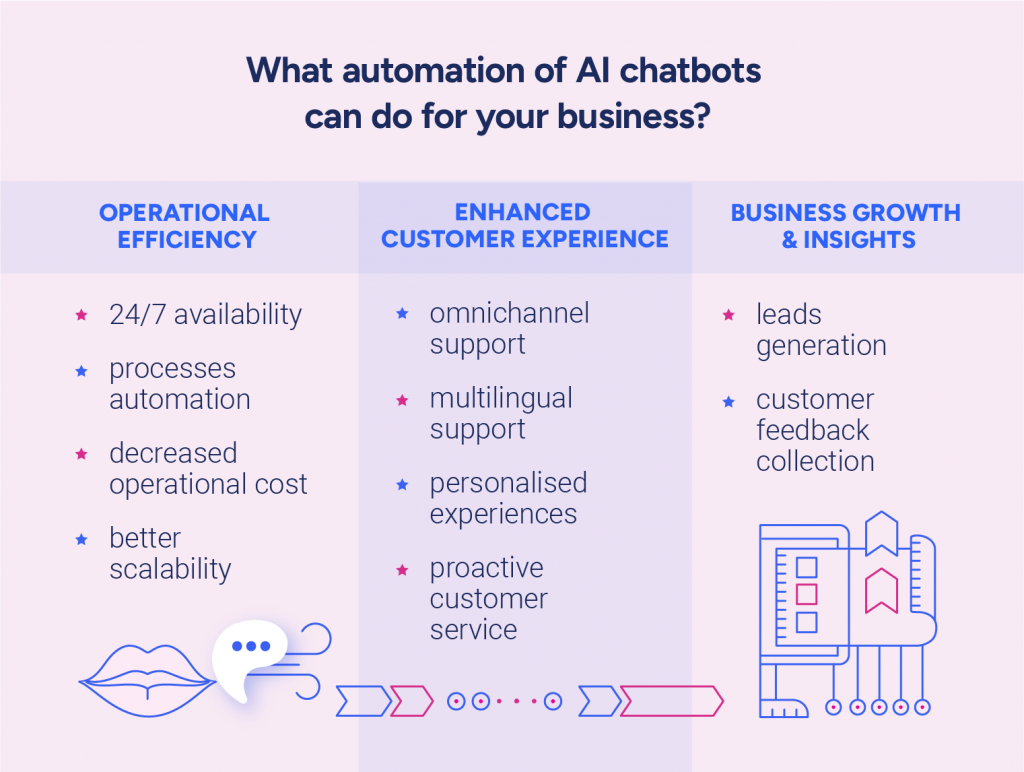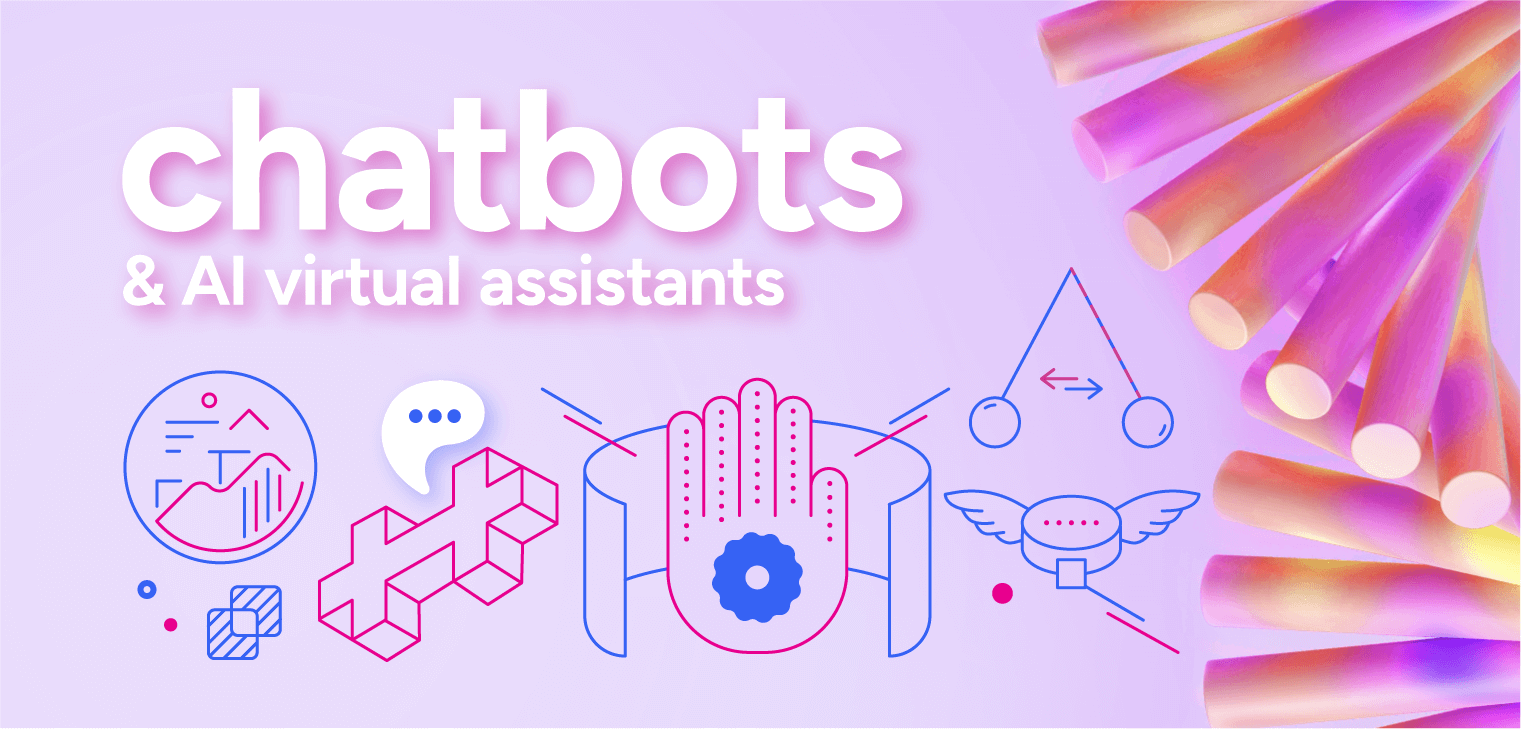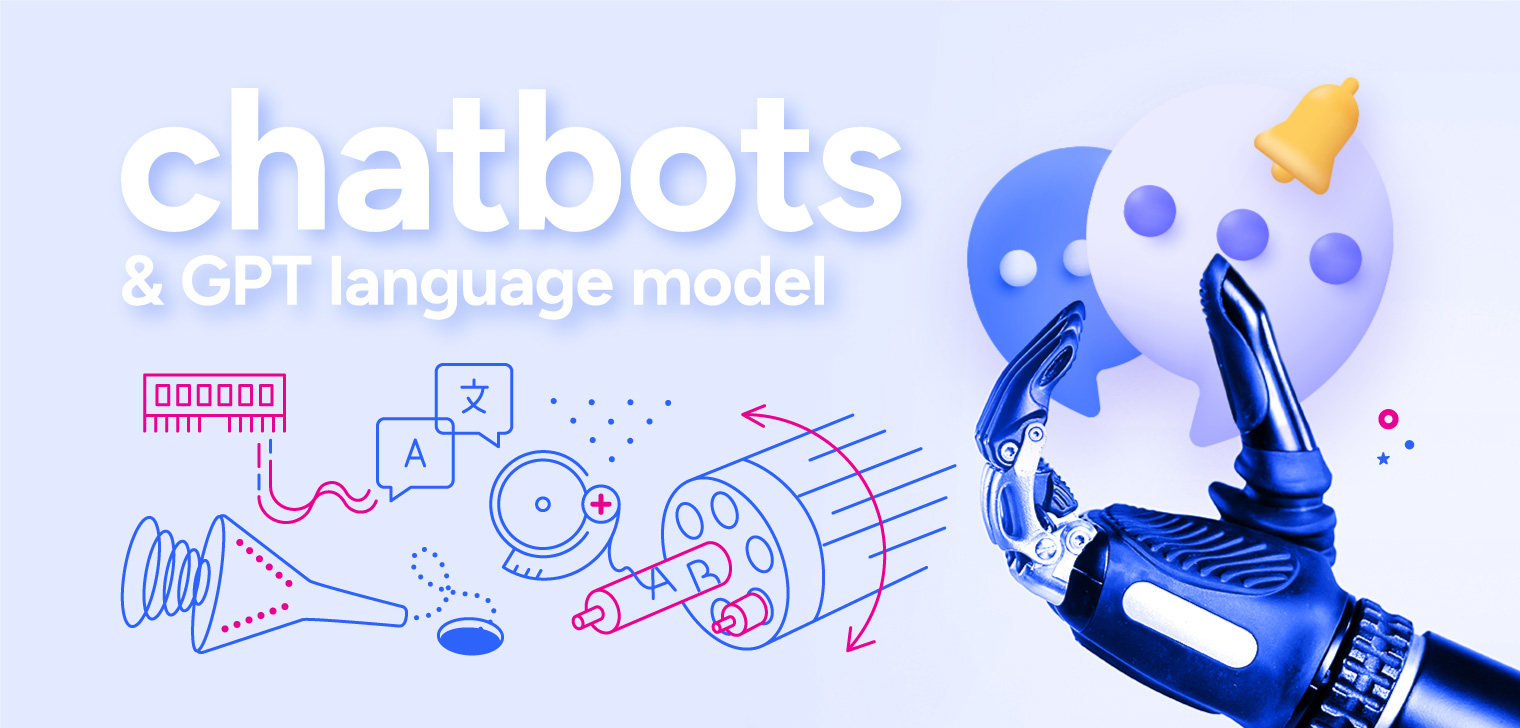A guide to AI chatbots – definitions and key concepts in 2024
Recently, businesses have increasingly adopted AI chatbots aiming to enhance customer interaction further, streamline operations, and provide better, more personalised experiences. Our guide to AI chatbots will ensure you are well-informed and up-to-date on all new trends regarding AI chatbots, which is more important than ever. Thankfully, our article gathers all the essential definitions of technologies and concepts that power AI chatbots, highlighting their potential. Familiarising yourself with these terms will be the first step if you want to leverage your business goals with the help of AI chatbots.
A guide to AI chatbots: What are AI chatbots and why do they matter?
An AI chatbot is an advanced software that uses artificial intelligence (AI) to simulate conversation with humans. Unlike traditional rule-based chatbots, which rely on predefined scripts and decision trees, AI chatbots leverage machine learning (ML) and natural language processing (NLP) to understand the context of each interaction and respond to user inputs in a more human-like and dynamic manner. This ability allows them to handle complex queries, learn from previous interactions, and improve over time.
)- 33.2% of US consumers will use AI banking chatbots by the end of 2024 (source: [eMarkete](https://www.emarketer.com/insights/chatbot-market-stats-trends/)r)- 25% of companies will use chatbots as their main customer service channel by 2027 (source: [Gartner](https://www.gartner.com/en/newsroom/press-releases/2022-07-27-gartner-predicts-chatbots-will-become-a-primary-customer-service-channel-within-five-years))- Worldwide retail spending on chatbots is set to reach $72 billion by 2028 (source:[Juniper Research](https://www.juniperresearch.com/press/retail-spend-over-chatbots-to-reach-12bn-globally/))](https://action.bot/wp-content/uploads/2024/09/ACBT_Blog32-EN-01-1024x819.png)
AI chatbots have recently gained popularity due to the release of ChatGPT in 2022, which showcased the potential of generative AI in engaging in natural conversations and generating coherent and relevant text. Since then, adopting generative AI has become a hot topic for various industries. Businesses leverage this technology to automate customer service, personalise user experiences, and streamline operations. The transformative impact of generative AI chatbots is reshaping how businesses interact with customers.
Key definitions and concepts surrounding AI chatbots
Understanding AI chatbots’ basic concepts and technologies is crucial to fully realising their potential. Below are essential terms and definitions you should be familiar with to explore their capabilities.
Artificial Intelligence (AI)
Artificial intelligence shows the machine’s ability to imitate intelligent human behaviour. In chatbots, AI involves developing algorithms that allow the system to learn from data, make data-driven decisions, and solve problems that mimic human logic. This enables chatbots to automate user interactions, handle complex queries, understand context, and provide accurate responses without human intervention. The complexity of AI in chatbots can vary from basic rule-based systems to advanced conversational AI.
Here are two key concepts that showcase AI’s capabilities:
- AI chatbots are designed to simulate human conversation. Unlike traditional chatbots that rely on predefined scripts and rules, AI chatbots utilise machine learning and natural language processing (NLP) for more dynamic and personalised interactions. They are widely used in customer service, e-commerce, and healthcare to automate routine tasks, answer common questions, and guide users through complex processes.
- Automation refers to using technology to perform tasks with minimal human intervention. It handles repetitive tasks such as answering common queries, processing orders, or scheduling appointments. By automating these tasks, AI chatbots can reduce the workload for human agents and ensure faster, more consistent service delivery, enhancing their efficiency and scalability.

Natural Language Processing (NLP)
Natural language processing (NLP) focuses on interactions between computers and humans using natural language. NLP allows chatbots to comprehend, interpret, and generate human language meaningfully. It can be done with several processes, such as tokenisation, where the chatbot breaks down text into smaller components, and semantic analysis, which determines the meaning behind words or phrases. NLP is essential for understanding user inputs and providing contextually relevant responses, making interactions with chatbots sound more natural.
To dive into this topic further, read our article about NLP chatbots.
Machine Learning (ML)
Machine learning enables computers to learn from data and improve their performance without being programmed. In AI chatbots, ML models are trained on large datasets to recognise patterns, make predictions, and adapt to new situations. This allows chatbots to polish their responses based on user interactions, making them more innovative and more effective in understanding and answering queries. ML is essential for personalising user experiences and continuously enhancing the chatbot’s capabilities.
Omnichannel
Omnichannel represents a seamless and integrated customer experience across multiple communication channels, such as websites, mobile apps, social media, and email. For AI chatbots, it means they can interact with users on any platform, ensuring consistent and coherent conversations regardless of where the interaction begins or continues. This approach enhances user satisfaction by providing flexibility and maintaining context across different touchpoints.
Text-to-speech (TTS)
Text-to-speech technology converts written text into spoken words, enabling chatbots to communicate with users through voice. This is particularly useful for creating more engaging and accessible user experiences, especially for those with visual impairments or when reading text is impractical. TTS technology is often paired with Automatic Speech Recognition (ASR) to create fully interactive voice-based chatbots.
Intent Recognition
Intent recognition is the process through which a chatbot determines what the user intends to accomplish based on their input. The chatbot provides more accurate and relevant responses by identifying the user’s intent. Intent recognition typically involves analysing keywords, phrases, and context within the user’s message. This capability is crucial for delivering meaningful interactions and ensuring the chatbot can handle various user queries effectively.
Customer Relationship Management (CRM)
Customer relationship management systems help businesses manage interactions with current and potential customers. Integrating AI chatbots with CRM systems allows automating tasks such as data entry, lead management, and customer support. By accessing customer data stored in CRM systems, chatbots can provide personalised responses, track customer interactions across multiple channels, and help businesses better understand customer needs and preferences.
Big Data
Big data refers to the vast volumes of structured and unstructured data that businesses generate daily. Big data is a critical resource for training machine learning models for AI chatbots, enabling them to analyse user behaviour, identify trends, and make more informed decisions. The ability to process and learn from big data allows chatbots to deliver highly personalised and context-aware interactions, improving customer satisfaction and business outcomes.
Generative Pre-trained Transformer (GPT)
GPT is an AI model that uses deep learning techniques to generate human-like text. These models are pre-trained on vast amounts of text data and can generate coherent and contextually relevant responses. GPT models are at the core of advanced conversational AI systems, allowing chatbots to produce more natural and sophisticated language, enhancing user interaction quality.
Here are the two examples of how we utilised GPT to improve customer experience:
- For Lancerto, a Polish men’s fashion brand, we implemented Actionbot to enhance customer interactions on its e-commerce platform. The AI assistant provided personalised fashion recommendations, addressed product queries, and assisted with order processing, resulting in an improved shopping experience.
Application Programming Interface (API)
An API is a set of protocols that allows different applications to communicate with each other. In the realm of AI chatbots, APIs enable the integration of chatbots with other systems such as CRM, ERP, and e-commerce platforms. This connectivity allows chatbots to access data, perform actions, and provide more comprehensive services to users. APIs are essential for creating a cohesive and functional chatbot ecosystem.
Sentiment Analysis
Sentiment analysis is the technique used to detect and interpret the emotions expressed in a user’s input. By analysing the tone and sentiment behind the words, chatbots can tailor their responses to match the user’s emotional state, leading to more empathetic and appropriate interactions. This capability is precious in customer service, where understanding a customer’s emotions can significantly improve support quality.
ChatOps
ChatOps is the practice of integrating chatbots with operational tools to streamline workflows and improve team collaboration. It allows DevOps teams to manage tasks such as deployments, monitoring, and incident management directly through chat platforms. By automating routine tasks and providing real-time insights, ChatOps enhances operational efficiency and helps teams respond more quickly to issues.
Conversational AI
Conversational AI encompasses all technologies that enable machines to engage in human-like conversations. This includes NLP, ML, and speech recognition. Unlike basic chatbots, which may rely on scripted responses, conversational AI systems can understand context, manage dialogues, and provide nuanced responses. That’s why they are more adaptable and practical in various areas, from customer service to virtual assistants.
Knowledge Base
A knowledge base is a centralised repository of information a chatbot can draw upon to provide accurate and consistent answers to user queries. This could include FAQs, manuals, policies, and more. A chatbot’s effectiveness often depends on the quality and comprehensiveness of its knowledge base, as this directly influences the accuracy of its responses. Knowledge bases are continually updated to ensure that chatbots remain relevant and valuable.
Automatic Speech Recognition (ASR)
Automatic speech recognition technology enables chatbots to convert spoken language into text. This is a critical component for voice-based chatbots, allowing them to process and understand user verbal inputs. ASR technology is used with NLP and TTS to create fully interactive voice-enabled chatbots that engage in natural conversation.
Robotic Process Automation (RPA)
Robotic process automation (RPA) involves using software robots to automate repetitive tasks typically performed by humans. In the chatbot context, RPA can automate data entry, order processing, and customer support processes. By integrating RPA with AI chatbots, businesses can further enhance efficiency, reduce operational costs, and ensure consistency in task execution.
Learn more about RPA chatbots from our blog post.
Optical Character Recognition (OCR)
Optical character recognition converts various documents, such as scanned papers or PDFs, into editable data. In chatbot applications, OCR can extract information from images or documents provided by users, allowing the chatbot to process and respond to queries that involve physical documents, such as invoices or forms.
Interactive Voice Response (IVR)
Interactive voice response technology allows a computer to interact with humans via a keypad via voice and DTMF tone input. IVR systems are primarily used in customer service to route calls to the appropriate department or to provide automated responses to common queries. When integrated with AI, IVR systems can offer more advanced interactions, such as understanding natural language inputs and providing more personalised responses.
Conversational Engine
A conversational engine is the core system that drives chatbot interactions. It processes user inputs, manages the dialogue flow, and generates appropriate responses based on predefined rules or AI models. A chatbot’s effectiveness largely depends on its conversational engine’s capabilities, which determine how well it can understand and respond to user queries, maintain context, and handle complex conversations.

For example, Actionbot leverages IBM watsonX Assistant to create an advanced conversational AI chatbot that provides seamless, human-like interactions. Integrating this AI-powered engine enhances customer experiences with quick, accurate responses and smooth omnichannel communication.
Read the full article about IBM watsonx Assistant – an AI-powered engine.
Choose a chatbot for the future – learn about Actionbot and its magic
Understanding these key concepts and implementing AI chatbots is now necessary for businesses that want to stay ahead of the competition. As one of the most advanced AI conversational chatbots on the market, Actionbot leads human-like conversations, puts them in the appropriate context, and elevates the customer experience to a new level.
Actionbot, based on the IBM WatsonX Assistant engine, offers advanced conversational AI capabilities that enable businesses to deliver seamless, human-like interactions across multiple channels. It also enhances customer service efficiency, providing accurate and timely responses while continuously improving thanks to machine learning.
Browse our case studies or contact us to see how our AI chatbot can revolutionise your business.


